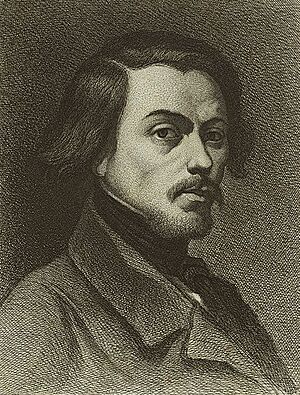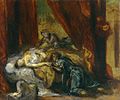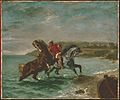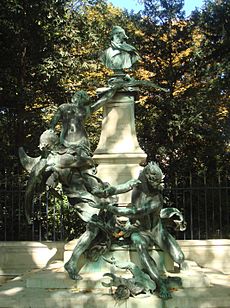Eugène Delacroix facts for kids
Quick facts for kids
Eugène Delacroix
|
|
|---|---|
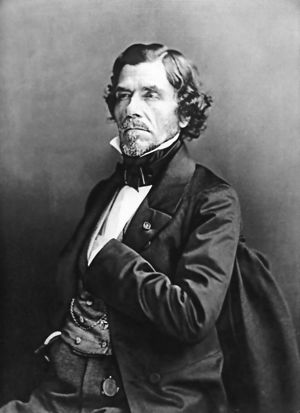
Eugène Delacroix, c. 1857 (photographed by Nadar)
|
|
| Born |
Ferdinand Victor Eugène Delacroix
26 April 1798 Charenton-Saint-Maurice, Île-de-France, France
|
| Died | 13 August 1863 (aged 65) Paris, France
|
| Known for | Painting, Lithography |
|
Notable work
|
Liberty Leading the People (1830) |
| Movement | Romanticism |
Ferdinand Victor Eugène Delacroix (born April 26, 1798 – died August 13, 1863) was a famous French artist. He was known as the leader of the French Romantic art movement from the very beginning of his career.
Unlike his main rival, Ingres, who focused on perfect, classical art, Delacroix found inspiration in the works of Rubens and painters from the Venetian Renaissance. This meant he cared more about using bright colours and showing movement in his paintings, rather than clear outlines and perfect shapes. His art often showed dramatic and emotional stories. Instead of looking to ancient Greek and Roman art, he traveled to North Africa to find new and exciting subjects.
Delacroix was a friend and artistic follower of Théodore Géricault. He was also inspired by the poet Lord Byron. Both artists loved showing strong feelings and powerful scenes from nature.
However, Delacroix was not overly emotional or boastful in his art. His Romantic style was very personal. The writer Baudelaire once said that Delacroix loved strong feelings, but he always tried to show them as clearly as possible. Delacroix is considered one of the last great "old Masters" of painting. He was also one of the few artists from his time who was ever photographed.
As a painter, Delacroix used bold brushstrokes and studied how colours looked next to each other. This greatly influenced the Impressionist artists who came after him. His love for exotic subjects also inspired the Symbolist movement. Delacroix was also a skilled lithographer. He created illustrations for books by famous writers like William Shakespeare, Walter Scott, and Johann Wolfgang von Goethe.
Contents
Early Life of Eugène Delacroix
Eugène Delacroix was born on April 26, 1798, in Charenton-Saint-Maurice, near Paris, France. His mother, Victoire Oeben, was the daughter of a skilled furniture maker.
He had three older brothers and sisters. His brother, Charles-Henri Delacroix, became a General in Napoleon's army. His sister, Henriette, married a diplomat. Another brother, Henri, sadly died in battle in 1807.
Some people believed that Eugène's biological father was not Charles-François Delacroix, but rather Talleyrand. Talleyrand was a family friend and a very important government official. He looked after Eugène throughout his life, helping him get many art commissions. Eugène's official father died in 1805, and his mother died in 1814, leaving 16-year-old Eugène an orphan.
Eugène went to school at Lycée Louis-le-Grand and Lycée Pierre Corneille. There, he studied classic subjects and won awards for his drawing. In 1815, he began training with Pierre-Narcisse Guérin. Guérin taught him the Neoclassical style, which was popular at the time.
One of Delacroix's early church paintings, The Virgin of the Harvest (1819), showed the influence of Raphael. However, another painting, The Virgin of the Sacred Heart (1821), was painted with more freedom. It showed the influence of the colourful style of the Flemish painter Peter Paul Rubens and the French artist Théodore Géricault. These artists helped bring the Romantic style into art.
Géricault's famous painting, The Raft of the Medusa, had a big impact on Delacroix. It inspired him to create his first major work, The Barque of Dante, which was shown at the Paris Salon in 1822. This painting caused a stir. Many people and officials didn't like it, but the government bought it for the Luxembourg Galleries. This pattern of his work being criticized but also strongly supported continued throughout his life. Two years later, he became popular again with his painting The Massacre at Chios.
Delacroix's Art Career
Paintings of Chios and Missolonghi
Delacroix's painting The Massacre at Chios shows sick and dying Greek civilians. They are about to be attacked by the Turks. This was one of several paintings he made about a real event happening at the time. It showed support for the Greek people in their fight for independence against the Turks. This war was supported by the English, Russian, and French governments.
Delacroix quickly became known as a leading painter in the new Romantic style. The government bought his painting. However, his depiction of suffering was controversial. There was no glorious moment shown, no heroes with swords. It was just a scene of disaster. Many critics didn't like the painting's sad mood. The artist Antoine-Jean Gros even called it "a massacre of art." After seeing paintings by John Constable and sketches by Richard Parkes Bonington, Delacroix made many changes to the sky and background of his painting.
Delacroix painted another work to support the Greeks in their fight for freedom. This one showed the capture of Missolonghi by Turkish forces in 1825. The painting is a tribute to the people of Missolonghi and to the idea of freedom against unfair rule. Delacroix was interested in this event not only because he supported the Greeks, but also because the poet Lord Byron, whom Delacroix greatly admired, had died there.
Romantic Art Style
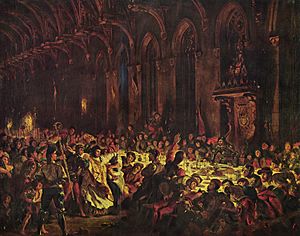
In 1825, Delacroix traveled to England. He visited artists like Thomas Lawrence and Richard Parkes Bonington. The colours and painting style of English art inspired him. This led to his only full-length portrait, the elegant Portrait of Louis-Auguste Schwiter (1826–30). Around the same time, Delacroix created many Romantic works with different themes. Many of these themes would interest him for over thirty years.
By 1825, he was making lithographs to illustrate Shakespeare's plays. Soon after, he made lithographs and paintings based on Goethe's Faust. Paintings like The Combat of the Giaour and Hassan (1826) and Woman with Parrot (1827) showed themes of intense action and beauty, which he would often return to.
These different Romantic ideas came together in The Death of Sardanapalus (1827–28). Delacroix's painting of the death of the Assyrian king Sardanapalus shows a very emotional scene. It is full of beautiful colours, exotic clothes, and dramatic events. The painting shows the king, whose city is under attack, watching calmly as his guards carry out his orders. The story came from a play by Byron.
Another painting that combined various Romantic interests was The Murder of the Bishop of Liège (1829). This painting was also inspired by a book, this time by Walter Scott. It shows a scene from the Middle Ages, depicting the murder of Louis de Bourbon, Bishop of Liège.
Liberty Leading the People
Delacroix's most famous work came in 1830 with the painting Liberty Leading the People. This painting clearly shows the difference between the Romantic style and the older Neoclassical style. It also differs from the Romanticism of Géricault, like in his painting The Raft of the Medusa.
Liberty Leading the People is probably Delacroix's most well-known painting. It shows a powerful image of Parisians, holding weapons, marching forward under the French flag. This flag represents liberty, equality, and brotherhood. Delacroix was inspired by real events to create this Romantic image of freedom. He seemed to want to show the spirit of the people, rather than just glorifying the actual event. This was the July Revolution of 1830, which led to a new king, Louis-Philippe. The fallen fighters in the front of the painting create a sad contrast to the symbolic female figure, who shines brightly against a smoky background.
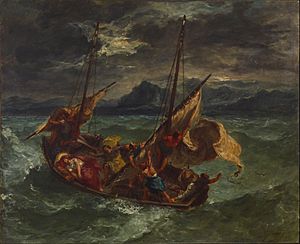
Even though the French government bought the painting, by 1832, officials thought its celebration of liberty was too strong. They removed it from public display. However, Delacroix still received many government jobs to paint murals and ceilings.
After the Revolutions of 1848, which ended King Louis Philippe's rule, Delacroix's painting Liberty Leading the People was finally put on display. This was done by the new President, Louis Napoleon (Napoleon III). Today, it is shown in the Louvre museum in Paris.
The boy holding a pistol in the painting is sometimes thought to have inspired the character of Gavroche in Victor Hugo's famous 1862 novel, Les Misérables.
Travel to North Africa
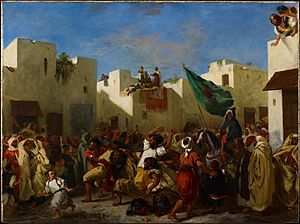
In 1832, Delacroix traveled to Spain and North Africa with a diplomat named Charles-Edgar de Mornay. This was part of a diplomatic trip to Morocco after the French had taken over Algeria. He didn't go mainly to study art. Instead, he wanted to escape the busy life of Paris and see a more "primitive" culture.
He ended up creating over 100 paintings and drawings based on the people and life in North Africa. This trip added a new and personal chapter to the art movement called Orientalism. Delacroix was fascinated by the people and their clothing. The trip would influence many of his future paintings.
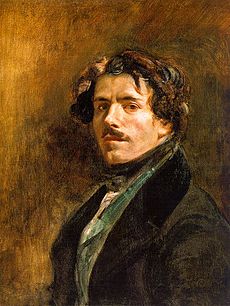
He managed to secretly sketch some women in Algiers, which led to his painting Women of Algiers in their Apartment (1834). However, it was generally hard for him to find Muslim women to pose because of their cultural rules about being covered. It was easier to paint Jewish women in North Africa, who became subjects for his Jewish Wedding in Morocco (1837–1841).
While in Tangier, Delacroix made many sketches of the people and the city. He would return to these subjects for the rest of his life. Animals, which represented strong emotions in Romantic art, were also included in his paintings. Examples include Arab Horses Fighting in a Stable (1860), The Lion Hunt (painted in many versions between 1856 and 1861), and Arab Saddling his Horse (1855).
Musical Inspirations for Delacroix
Delacroix found inspiration from many places throughout his career. These included the writings of William Shakespeare and Lord Byron, and the art of Michelangelo. But, throughout his life, he always felt a strong need for music. In 1855, he said that "nothing can be compared with the emotion caused by music." He also said that music put him in a state of "exaltation" that inspired his painting.
Often, it was from music, whether sad pieces by Frédéric Chopin or calm works by Ludwig van Beethoven, that Delacroix found the most emotion and inspiration. At one point, Delacroix became friends with the composer Chopin and painted his portrait. In his personal journal, Delacroix often praised Chopin.
Murals and Later Life
In 1838, Delacroix showed his painting Medea about to Kill Her Children. This painting caused a sensation at the Salon. It was his first large painting based on a scene from Greek mythology. It shows Medea, a figure from Greek myths, in a moment of great sadness and anger, holding her children. Even though the government quickly bought the painting, Delacroix was disappointed when it was sent to the Lille Musée des Beaux-Arts. He had wanted it to be displayed at the Luxembourg, alongside his other famous works.
From 1833 onwards, Delacroix received many jobs to decorate public buildings in Paris. That year, he started work for the Salon du Roi in the Chambre des Députés, Palais Bourbon. This project took until 1837 to finish. He also became lifelong friends with the artist Marie-Élisabeth Blavot-Boulanger. For the next ten years, he painted in the Library at the Palais Bourbon and the Library at the Palais du Luxembourg. In 1843, he decorated the Church of St. Denis du Saint Sacrement with a large Pietà. From 1848 to 1850, he painted the ceiling in the Galerie d'Apollon of the Louvre.
From 1857 to 1861, he worked on large wall paintings (frescoes) for the Chapelle des Anges at the Church of Saint-Sulpice in Paris. These included "Jacob Wrestling with the Angel", "Saint Michael Slaying the Dragon", and "The Expulsion of Heliodorus from the Temple". These important jobs gave him the chance to create large-scale art in grand buildings, just like the masters he admired, such as Paolo Veronese, Tintoretto, and Rubens.
This work was very tiring, and during these years, his health became weaker. Besides his home in Paris, from 1844, he also lived in a small cottage in Champrosay. There, he found peace in the countryside. From 1834 until his death, his housekeeper, Jeanne-Marie le Guillou, took faithful care of him. She protected his privacy, and her dedication helped him live longer and continue working in his later years.
In 1862, Delacroix helped create the Société Nationale des Beaux-Arts, an art society. His friend, the writer Théophile Gautier, became its chairman. Just after Delacroix's death in 1863, the society held a special exhibition. It showed 248 of his paintings and lithographs.
The winter of 1862–63 was very hard for Delacroix. He had a bad throat infection that kept getting worse. On August 13, Delacroix died, with his loyal housekeeper Jenny by his side. He was buried in Père Lachaise Cemetery in Paris.
Gallery
-
Orphan Girl at the Cemetery, 1823, Louvre
-
The Combat of the Giaour and Hassan, 1826, Art Institute of Chicago
-
A Young Tiger Playing with its Mother, 1830, Louvre
-
The Duke of Morny's Apartment, 1831–1833, Louvre
-
Portrait of Dr. François-Marie Desmaisons, 1832–33, Detroit Institute of Arts
-
The Women of Algiers, 1834, Louvre
-
The Battle of Taillebourg (draft), 1834–35, Louvre
-
Frédéric Chopin, 1838, Louvre
-
Columbus and His Son at La Rábida, 1838, National Gallery of Art
-
Jewish Wedding in Morocco, c.1839, Louvre
-
Christ on the Sea of Galilee, 1841, Nelson-Atkins Museum of Art
-
Collision of Moorish Horsemen, 1844, Walters Art Museum
-
Saint George Fighting the Dragon, 1847, Louvre Museum
-
Desdemona Cursed by her Father (Desdemona maudite par son père), c.1850–1854, Brooklyn Museum
-
1855, Moroccan Saddles His Horse, Hermitage Museum
-
The Bride of Abydos, 1857, Louvre
-
Horses Leaving the Sea, 1860, The Phillips Collection
-
Lion Hunt (1860/61), Art Institute of Chicago
-
Shipwreck on the Coast, 1862, Museum of Fine Arts, Houston
-
Ovid among the Scythians, 1862, version in Metropolitan Museum of Art
-
Charioteers, pen and ink on paper, National Gallery of Art
-
Two Studies of an Indian from Calcutta, Seated and Standing, c. 1823–24, National Gallery of Art
Delacroix's Legacy
When his artworks were sold in 1864, there were 9,140 pieces attributed to Delacroix. This included 853 paintings, 1,525 pastels and watercolours, 6,629 drawings, 109 lithographs, and over 60 sketchbooks. The large number and high quality of his drawings showed how important drawing was to him. He once said, "Colour always occupies me, but drawing preoccupies me."
Delacroix created several excellent self-portraits. He also painted many memorable portraits just for fun. These include the portrait of fellow artist Baron Schwiter, a small oil painting of the violinist Niccolò Paganini, and a double portrait of his friends, the composer Frédéric Chopin and writer George Sand. Sadly, this double portrait was cut after his death, but the individual portraits still exist.
Sometimes, Delacroix painted pure landscapes, like The Sea at Dieppe (1852), and still lifes, like Still Life with Lobsters (1826–27). Both types of paintings showed his amazing skill. He is also well known for his Journal, where he wrote down his thoughts about art and life.
A whole generation of Impressionist artists were inspired by Delacroix's work. Artists like Renoir and Manet made copies of his paintings. Degas even bought the portrait of Baron Schwiter for his own collection. His painting at the church of Saint-Sulpice has been called the "finest mural painting of his time."
The Chinese artist Yue Minjun has created his own version of Delacroix's painting Massacre of Chios, keeping the same name. Yue Minjun's painting was sold for almost $4.1 million in 2007.
His pencil drawing Moorish Conversation on a Terrace was found as part of the Munich Art Hoard.
See also
 In Spanish: Eugène Delacroix para niños
In Spanish: Eugène Delacroix para niños


